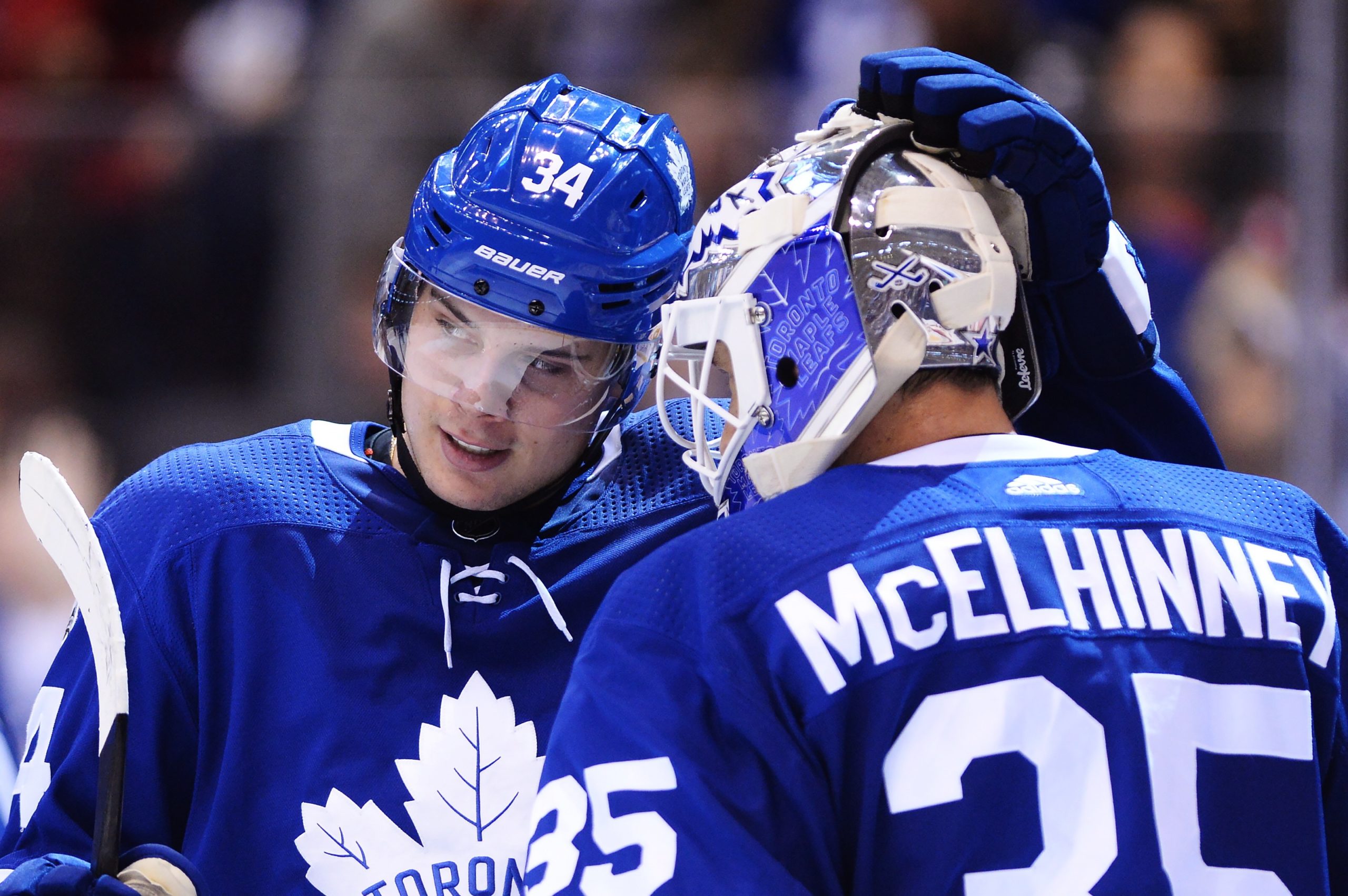Tuesday’s waiver-wire action brought with it some bad news for the Toronto Maple Leafs’ goaltending depth: Curtis McElhinney has been claimed by Carolina, while Calvin Pickard is headed to Philadelphia.
Certainly, this wasn’t the preferred outcome from Leafs management’s perspective, but losing two of their four waiver-eligible NHL goaltenders was always a possibility. Carrying three was not an idea the Leafs management, coaching and development staffs were fond of, based on other roster pressures and Kyle Dubas’ comment about the inconvenience of splitting the practice net between two backups.
Knowing that, the Leafs were always going to risk losing two of three on waivers. It’s just a question of which two they were going to expose:
- The experienced backup who is a known quantity, put up the best backup numbers in the league last season, and looked sharp in camp for the most part (Curtis McElhinney).
I - The 25-year-old 2018 AHL goaltender of the year and Calder Cup champion who struggled in his NHL stint in 2015-16 and didn’t fare well in preseason (Garret Sparks).
I - The Marlies‘ 1B last season in Calvin Pickard, who has proven he could do the backup job role well in Colorado and even carried the load competently for them for a time in 2015-16, earning him the starter’s job for Team Canada at the 2016 World Championships, where he performed well.
It’s possible one or both McElhinney or Pickard are available to the Leafs again on waivers at some point in the near future depending on how the health and performance of the Flyers and Hurricanes goaltending situations play out. That would give the Leafs a couple weeks to see how Sparks fares — starting as soon as the first weekend of the season in Chicago, their first back-to-back of the year — and then they can reassess where things stand.
But it’s also possible neither ends up back on waivers and there is no guarantee the Leafs would win the claim if they do. That’s the risk the Leafs have taken here: They could be back at square one — where they were prior to the McElhinney claim in the winter of 2017 — searching for a competent backup midseason should the unproven guy in Sparks not pan out. In the choice between having a question mark on the Marlies, or a question mark at your NHL backup position and a question mark on the Marlies, the Leafs went in the direction of the latter, thinking Sparks is worth taking the risk for.
Taking a step back for a minute, as much as it should be appreciated that the Leafs want to reward homegrown talent who accomplished great things with the Marlies, the whole thing could prove to be an exercise in fiddling with an unbroken situation.
It’s not like Sparks is going to be in a 1B situation pushing Andersen for starts. He’s a “pure” backup who is going to need to pitch in for 20 games. His age plays a role, but McElhinney just got waived despite putting up the best numbers of any backup goaltender last year. As did the much younger Pickard, who is a good goalie with an NHL resume of his own. Sparks’ value is not going to appreciate notably even if he does prove he can be a competent backup in the next couple of years. That is just the nature of the goaltender market. Therefore, the asset management angle seems secondary to ensuring the Leafs have a quality backup available to them this year. After all, they’re trying to win Cups as soon as this season.
In that sense, the question has to be asked: Why not go with the veteran who is still at the top of his game, based on recent history and his most recent preseason performances, who has proven he thrives in the backup role supporting Andersen (much different than starting regularly)? Or give Calvin Pickard — who has carried the load before in the NHL capably, which is relevant should an Andersen injury ever occur — a more honest look than they did in preseason? Goaltending depth is relatively easy to acquire in the offseason and it shouldn’t be difficult to do so once McElhinney rides off into the sunset. The only time it could really become an issue is if you find yourself in the middle of the season, hoping to contend for a divisional title and a Stanley Cup, and you don’t have a quality backup on the NHL roster. And that’s the situation the Leafs risk putting themselves in here.
It’s all irrelevant if Sparks can prove Kyle Dubas was right to have placed his faith in him. The pressure just ratcheted up a notch, though, because the insurance policies have left town.
The Marlies situation
By Mark Rackham
Much of the Marlies success last season was built on the foundation of the league’s best goaltending tandem. It’s going to look a lot different between the pipes in 2018-19 with Sparks’ promotion to the Maple Leafs and the loss of Pickard (and McElhinney) through waivers.
Kasimir Kaskisuo was the anointed number one heading into the season, whatever the outcome of waivers, and this is his chance to show the organization what he can do.
The Finnish netminder doesn’t own a large body of work in the American League with just 38 career outings to his name. The 25-year-old played 28 games on loan for Chicago last season and posted a .916 save percentage — just a fraction below his career to date and good for 15th among all AHL goaltenders in that category. A lone start with the Marlies saw Kaskisuo stop 26 of 27 shots — a game that left a strong impression and gave some indication he could be ready to take a step up in 2018-19.
What the Toronto Marlies lack right now is depth to their goaltending, with Eamon McAdam the only current option on paper. Michael Garteig is signed with Newfoundland Growlers on an ECHL deal, which leaves Justin Peters as the other viable option. This exact scenario is most likely why the veteran goaltender was invited to camp. Peters could either be signed to a PTO to begin the season or an AHL deal to provide long-term cover.



![Sheldon Keefe on the Maple Leafs’ struggling power play: “[We’ve scored] one out of 11 high-danger chances in tight to the net… We have been in those spots and haven’t converted” Sheldon Keefe, playoff press conference](https://mapleleafshotstove.com/wp-content/uploads/2024/04/keefe-pc-game-3-218x150.jpg)

![Jim Montgomery Post Game, Bruins 4 vs. Leafs 2: “[Marchand] still manages to get under people’s skin, yet he doesn’t cross the line” Jim Montgomery, Boston Bruins post game](https://mapleleafshotstove.com/wp-content/uploads/2024/04/jim-monty-pg-to-218x150.jpg)
























![Sheldon Keefe on the Maple Leafs’ struggling power play: “[We’ve scored] one out of 11 high-danger chances in tight to the net… We have been in those spots and haven’t converted” Sheldon Keefe, playoff press conference](https://mapleleafshotstove.com/wp-content/uploads/2024/04/keefe-pc-game-3-100x70.jpg)



![Jim Montgomery Post Game, Bruins 4 vs. Leafs 2: “[Marchand] still manages to get under people’s skin, yet he doesn’t cross the line” Jim Montgomery, Boston Bruins post game](https://mapleleafshotstove.com/wp-content/uploads/2024/04/jim-monty-pg-to-100x70.jpg)
